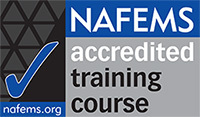This course has now been retired, and it's contents incorporated into the expanded "Introduction to Practical CFD" course.
Do you need a more accurate approach to include fluid loads or thermal boundary conditions for structural analyses than idealized and simplified approaches?
Do you know the important fluid dynamics phenomena in multidisciplinary problems?
What is the role of CFD in strongly coupled fluid-structure interactions?
Get the answers to these questions and more with this industry-leading, code-independent e-learning course.
CFD for Structural Designers & Analysts
This 3-session, live online course will cover a range of topics, all aimed at the structural designer and analyst who needs to get to grips with CFD, including:
- Principles of fluid dynamics
- Important flow phenomena
- Basics of the CFD process
- Turbulence modelling
- Fluid-structure interaction.
You can either attend the live sessions or take the course on-demand at your leisure.
NAFEMS e-learning gives you the best of both worlds, giving you real, practical knowledge that you can use day-to-day to improve your analyses.
What will you learn?
- Important flow concepts
- Basics of CFD
- Turbulence modelling and heat transfer
- Physical and numerical coupling of CFD and structural analyses
What questions will this course answer?
- What are the important fluid dynamic phenomena that may appear in FSI problems?
- What are the basic steps in a CFD process?
- What is physical and numerical coupling in FSI problems?
Who should attend?
- Structural engineers, designers & analysts aiming to incorporate CFD into their everyday practice
- Structural engineers not directly using CFD, who need to work with or support CFD analysts
Structural engineers often need to resort to more sophisticated thermal fluid simulations to obtain boundary conditions, loading, performance, etc. for their designs and analyses. This course aims to introduce important concepts to structural engineers for their multidisciplinary problems.
The course will provide an overview of the essential principles of fluid dynamics, important flow phenomena, basics of CFD process, turbulence modelling, heat transfer, and physical and numerical coupling of CFDs and structural analyses in FSI problems through simple examples and case studies.
The course is completely code independent.
- A full set of notes in PDF format will be available for download. Each session is presented live and is available for review via a streamable recording.
- Personal passwords are provided to allow you to access e-learning backup material via our special bulletin board. Reading lists, homework submissions, supplementary data are all stored as files on the bulletin board.
- Interaction via the bulletin board is strongly encouraged to obtain the most from the e-learning class. Typically the board runs for 4 weeks after the last live class sessions, giving you plenty of time to catch up with homework, review and ask questions.
Note: homework is purely voluntary!
Course Process and Details
Students will join the audio portion of the meetings by utilizing the VoIP (i.e. headset connected to the computer via headphone and microphone jacks) or by calling into a standard toll line. If you are interested in additional pricing to call-in using a toll-free line, please send an email to: e-learning @ nafems.org .
Course Program
Note: This is a three-week course. Each session represents one 2.5-hour session each week.
Session 1
- Need for CFD: loads and boundary conditions
- Definitions and governing principles of fluid dynamics
- Introduction to CFD
- Model simplification
- Grid generation
- Differencing
- Post-processing
Session 2
- Flow Types:
- Steady / transient flows
- Viscous / inviscid flows
- Laminar / turbulent flows
- Multiphase flows
- Important concepts and phenomena
- Heat transfer
Session 3
- Understanding turbulence
- Turbulence modeling
- Structural and CFD simulation Coupling
- Weak, Strong, very strong coupling
- 1-way, 2-way, fully coupled
Special Note(s):
Telephony surcharges may apply for attendees who are located outside of North America, South America and Europe. These surcharges are related to individuals who join the audio portion of the web-meeting by calling in to the provided toll/toll-free teleconferencing lines. We have made a VoIP option available so anyone attending the class can join using a headset (headphones) connected to the computer. There is no associated surcharge to utilize the VoIP option, and is actually encouraged to ensure NAFEMS is able to keep the e-Learning course fees as low as possible. Please send an email to the e-Learning coordinator (e-learning @ nafems.org ) to determine if these surcharges may apply to your specific case.
Just as with a live face-to-face training course, each registration only covers one person. If you plan to register a large group (10+), please send an email to e-learning @ nafems.org in advance for group discounts.
For NAFEMS cancellation and transfer policy, click here.





